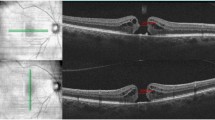Abstract
Purpose: To perform quantitative three-dimensional analysis of changes of idiopathic full-thickness stage 3 macular holes following vitrectomy and gas tamponade using confocal scanning laser tomography to study the mechanism of repairing the holes and to correlate with visual recovery. Methods: We studied 44 patients, 10 men and 34 women, aged between 40 and 76 years (mean 65.5 years) with stage 3 macular holes with symptoms of 1–4 months’ duration (mean 2.7 months). Using the Heidelberg Retina Tomograph, we measured the macular area within 1 week before surgery (3.5±1.6 days), and between 2 and 4 weeks (2.4±0.6 weeks) and at least 3 months (3.8±0.8 months) after surgery.Results: All 44 eyes showed closure of the holes and flattening of cuff and retinal striae after vitrec- tomy and gas tamponade. All the eyes showed small flat depressions that corresponded to each macular hole with the area of 0.027–0.184 mm2 (0.110±0.042 mm2). Thirty-nine (89%) of 44 eyes showed large concave depressions that appeared to correspond to the preoperative retinal striae, with areas of 0.844 to 5.563 mm2 (3.688±1.263 mm2). The areas of the postoperative small depressions and large depressions were significantly correlated with the area, volume, and depth of the macular holes and the area of the cuff and retinal striae prior to treatment. Postoperative visual acuity showed significant correlations with the areas of the postoperative small depressions and large depressions. Conclusions: Confocal scanning laser tomography is potentially useful as a noninvasive diagnostic technique for quantitative measurements of changes of macular holes by vitrectomy and gas tamponade. Post-operative small depressions corresponding to the healed macular holes appeared to be caused by gliosis involving sealing of the holes. The large depressions and their concave shape may result from postoperative changes of the retina, including swelling of ganglion cells and loss of outer and inner segments of photoreceptor cells in regions of preoperative cuff and retinal striae.
Similar content being viewed by others
Author information
Authors and Affiliations
Additional information
Received: 9 February 1999 Revised: 14 June 1999 Accepted: 25 August 1999
Rights and permissions
About this article
Cite this article
Kobayashi, H., Kobayashi, K. Quantitative measurements of changes of idiopathic stage 3 macular holes after vitrectomy using confocal scanning laser tomography. Graefe's Arch Clin Exp Ophthalmol 238, 410–419 (2000). https://doi.org/10.1007/s004170050372
Issue Date:
DOI: https://doi.org/10.1007/s004170050372




